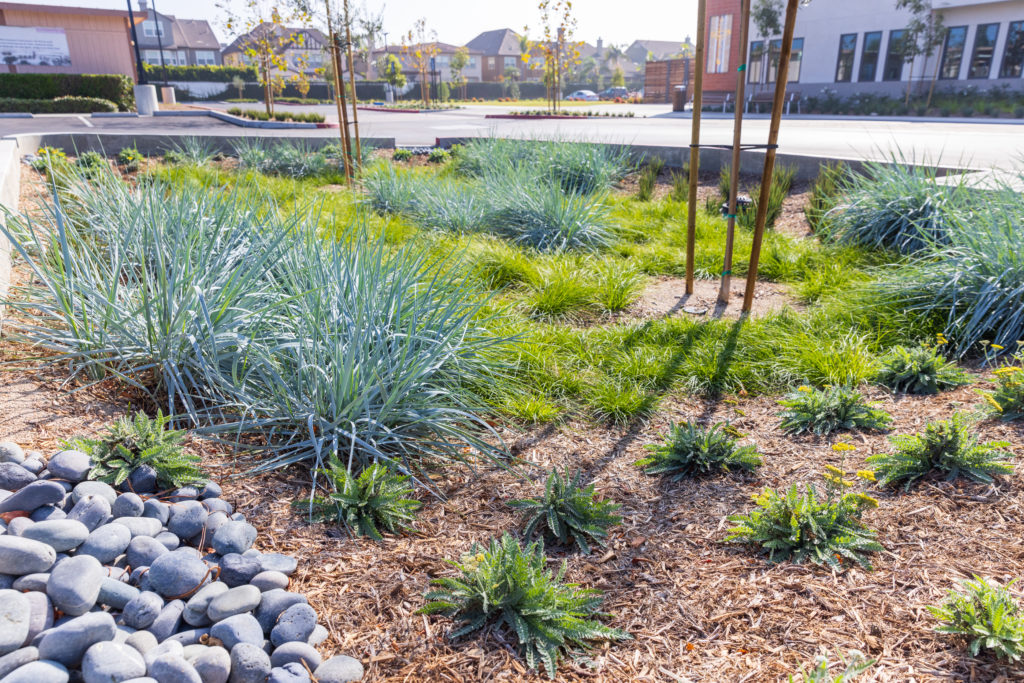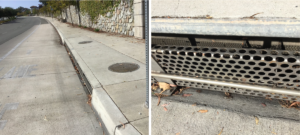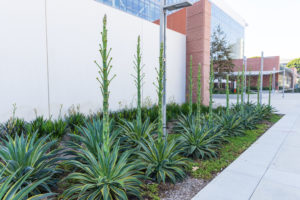Get to Know Orange County’s Stormwater Design Features
December 21, 2021

Scattered throughout the urban Orange County landscape are stormwater design features that you might not have known existed. Or, when walking past them, you might have admired their beauty but not considered their purpose. Structures like rain gardens, dry creek beds, and permeable pavement are installed throughout Orange County communities and play a vital role in protecting OC’s water quality.
When water flows from properties or the street into the storm drain system, it can also bring pollutants. Since water in the storm drain system is not treated before entering our waterways, pollutants like trash and pet waste can flow into our lakes, creeks, rivers, and ocean. The stormwater design features built into our communities serve as buffers that help prevent pollutants from harming our waterways.
Let’s explore some common stormwater design features and how they benefit Orange County residents.
Types of Stormwater Design Features
There are many kinds of stormwater design features throughout your neighborhood, but they all have the same goal in common – preventing pollution. Try to find them next time you are out and about as they tend to hide in plain sight.
Rain Gardens and Dry Creek Beds
Rain gardens and dry creek beds act as living water filters. They are designed to promote infiltration by holding and treating rainwater as it soaks into the ground. First, the rocks or plants trap larger items such as trash and debris as the water passes over them. Then, the soils and plants slow down the water which allows it to soak into the ground. The microbes in the soil breakdown pollutants and prevent them from reaching storm drains.
Rain gardens work best when filled with native and California-friendly vegetation like California fuschia or wood rose. These plants are used because they’ve adapted to our climate and can survive with less water and maintenance than traditional turf.
 Rain garden at the Lake Forest Community Center
Rain garden at the Lake Forest Community Center
Dry creek beds are similar to rain gardens, but typically have less plant life. They are shallow ditches filled with stones of different sizes. When paired with California-friendly plants, these features help reduce runoff pollution and add aesthetic value.
 Dry creek bed at Maybury Park in the City of Santa Ana
Dry creek bed at Maybury Park in the City of Santa Ana
You will usually find rain gardens and dry creek beds next to buildings, along streets and sidewalks, in parking lots, or other locations near impermeable surfaces. Even though these stormwater design features may seem purely aesthetic, they effectively reduce stormwater pollution, create small habitats for wildlife, and reduce erosion!
Permeable Pavement and Drain Inserts
While rain gardens and dry creek beds are designed to mimic what is found in nature, there are other non-living stormwater design features around your neighborhood that help reduce runoff pollution too!
Permeable pavement adds pollution prevention to the functionality of streets and sidewalks. By replacing solid cement or asphalt with permeable pavement, runoff (along with any harmful pollutants it picked up) is able to soak into the ground below rather than run off into the storm drain. Think of these permeable alternatives as subtle pollutant drains under your feet.
 Permeable pavement at the Lake Forest Community Center
Permeable pavement at the Lake Forest Community Center
Similarly, drain inserts are hidden pollutant traps located within the storm drain itself. These inserts are made up of screens that allow water to pass through but catch trash and debris like food wrappers and cigarette butts. Through regular maintenance, this trash is then removed and discarded properly. Even out of sight, these stormwater design features work hard to keep trash from reaching our waterways. Since 80% of marine trash comes from land-based sources, permeable pavement and drain inserts are effective tools for keeping Orange County’s waterways thriving and protective of aquatic life.
 Metal Drain Insert in the City of Laguna Woods
Metal Drain Insert in the City of Laguna Woods
Community Benefits
The primary benefits of these stormwater design features are, of course, to prevent runoff pollution and protect water quality. However, they also provide several other benefits including:
1. Reduces local temperatures.
The summer heat in Orange County can be intense. Areas with high concentrations of pavement, buildings, and other heat-retaining surfaces can increase local temperatures significantly and be dangerous for vulnerable populations. Stormwater design features like rain gardens decrease the temperature immediately surrounding them by providing green space in otherwise concrete-dominated urban environments.
2. Enhances the appearance of urban spaces.
Native plants in rain gardens and surrounding dry creek beds bring much-needed color and life to urban areas. While protecting our waterways, they tremendously increase the charm of our communities!
3. Saves water.
Water that soaks into the ground can increase groundwater supply and reduce the amount of water used by municipalities, and collected rainwater can be used for outdoor irrigation. With California currently experiencing drought conditions, saving as much water as possible is vital.
4. Reduces erosion.
Stormwater design features treat and reduce the amount of rainwater draining to OC’s waterways compared to conventional drainage infrastructure. Slower moving water helps keep soil and sediment in place, which helps reduce erosion.
5. Prevents flooding.
Stormwater design features capture trash and yard debris like leaves before they can get caught and clog up a storm drain. Free-flowing drains decrease the chance of localized flooding.
 Permeable pavement at the Lake Forest Community Center
Permeable pavement at the Lake Forest Community Center
Stormwater design features are great tools for preserving water quality, preventing beach closures, and protecting animal and human health. These rain gardens, dry creek beds, permeable pavement, and drain inserts serve our communities 365 days a year and look good doing it!
However, these features can’t be installed in every situation. It’s important to keep in mind that you are the solution to ensure harmful runoff from your property doesn’t get into the storm drain system. When we take action to protect our waterways, pollution doesn’t stand a chance! Join your friends and neighbors in protecting our waterways from runoff pollution.
How You Can Help
December is in the heart of the rainy season, which means the higher volume of stormwater can lead to more runoff now compared to the summer! Follow these tips to protect Orange County’s lakes, creeks, rivers, and ocean:
1. Clean your yard. By sweeping and disposing of debris, picking up pet waste, and storing household hazardous materials indoors or under cover, you can prevent the rain from taking contaminants into the storm drain system.
2. Keep waste bins and compost piles covered. When these bins are covered, wind and rain can’t blow trash and other waste into the storm drain system. This simple act can also increase the longevity and effectiveness of our drain inserts.
3. Skip watering before, during, and after a rain event. Overwatering is wasteful and can cause runoff to flow into the storm drain system, picking up pollutants along the way. By checking the forecast and adjusting your watering schedule, you can save water while protecting our waterways from unnecessary runoff pollution.
4. Build a rain garden. Inspired by the beautiful and living stormwater features above? You can create a similar one right in your own yard! Visit our rain garden page here for more information.
Thank you for doing your part to protect Orange County’s waterways this rainy season. Here are additional resources to help you prepare for the rainy season in OC:
- Looking for guidance on how much water your yard needs? In addition to running your system to check for runoff, you can find watering guidelines and customizable calculators from bewaterwise.com and the Municipal Water District of Orange County.
- Interested in updating your irrigation system? Rebates may be available for weather-based irrigation controllers, upgraded sprinkler nozzles, drip irrigation, and rain barrels to capture water and prevent runoff. Check your local water district for current rebate programs.
- Wondering how to monitor your yard’s watering needs? Moisture meters feature easy-to-read dials to indicate if the soil is dry, moist, or wet. You can find moisture meters and soil moisture sensors at home improvement stores and irrigation supply stores. Rebates may also be available.
For more ways to prevent overwatering and runoff, check out our Landscape Improvement and Capture Water pages for additional modifications you can make to your landscape to protect our local waterways and ocean.
Great article, very informative. I’m glad I came here.
Okay so, just dropping this here since we do not have much forums where I can find my answer on; which stormwater modeling software are you using? And what are your opinions about GeoHECHMS by CivilGEO?
H2OC Stormwater Program Post author
Hi Sara, we appreciate your interest. We use a variety of tools with varying degrees of application. But, due to the nature of your inquiry, we would like to have a conversation via email to get into more detail. We will get in touch with you in the coming weeks. Have a wonderful weekend!
Very informative presentation. It will be helpful elsewhere in educating residents on what’s possible for stormwater control. My only suggestion is to include more photos of the BMPs.
Thanks!
H2OC Stormwater Program Post author
Hello Fred! We really appreciate your feedback and we’ll definitely take your suggestion into consideration for future blog posts. For more photo-based content, please visit our Facebook page here: https://www.facebook.com/ocstormwater and our Instagram page here: https://www.instagram.com/ocstormwater/. Have a terrific day!
I’m in the process of composing a university paper, I’ve recently discovered the purpose of rain gardens and dry creek beds, some of which were newly installed near my workplace. This revelation has genuinely surprised me.
H2OC Stormwater Program Post author
Hi Sergio! We’re glad you were able to recognize stormwater design features near your workplace! These stormwater design features, like rain gardens and dry creek beds, can be terrific tools to prevent runoff pollution and protect our waterways. We hope you have a wonderful day and continue to recognize more stormwater design features in your community! ?